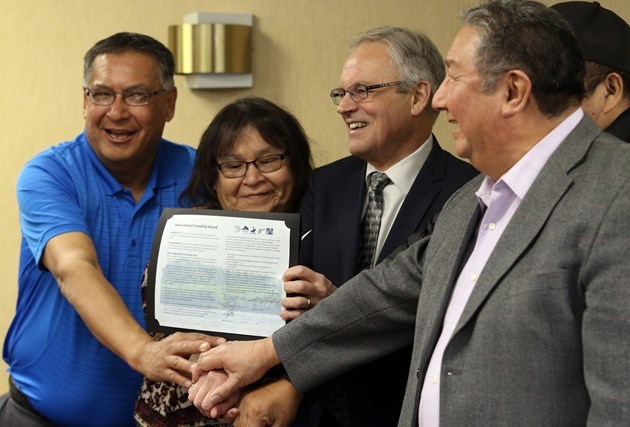A group of northwestern Ontario First Nation communities were heading to the Prospectors and Developers Association of Canada’s (PDAC) mining show in March as a “unified voice” in looking to benefit from resource development in their traditional territories.
The communities of Cat Lake, Slate Falls, and Lac Seul have agreed in principle to a Shared Territory Protocol agreement which will be presented at the world’s largest mining industry trade show this week.
“My message is, if you involve us correctly, there is no limit to what we can all do,” said Russell Wesley, communication coordinator at Windigo First Nations Council, a Sioux Lookout-based tribal council of seven communities in northwestern Ontario.
Wesley and the chiefs will be part of a delegation that includes the Municipality of Sioux Lookout, which is making its second official appearance at PDAC, and has a growing Friendship Accord with these communities as Sioux Lookout looks to promote the region’s gold, nickel, copper and iron ore prospects.
The communities belonging to the Windigo tribal council have proven to be more than capable of participating in natural resource development based on their ownership in a number First Nation-owned service companies with an abundance of skilled labour on hand.
“Windigo First Nations Council has evolved into a strong tribal council with serious business interests,” said Wesley.
Award-winning Windigo Catering is a large and expanding Sioux Lookout-based operation that services Goldcorp’s Musselwhite Mine and the crews stationed at the Ministry of Natural Resources’ fire bases.
Another member-owned company is Boreal Solutions. Headquartered in Thunder Bay with an office in Sault Ste. Marie, it provides environmentally-friendly janitorial services and cleaning supplies to a variety of clients and is looking at expanding into other markets and provinces.
Some members have ownership in the White Cedar Pharmacy chain in northwestern Ontario and are owners of Pipestone Contracting, a profitable multi-million dollar construction operation that built most of the Musselwhite Mine.
Others have partial ownership stakes in companies like North Star Air.
Windigo Tribal Council, itself, was the driving force behind the creation of Wataynikaneyap (Watay) Power, a licensed transmission company owned by 22 First Nation communities, created through a partnership with Goldcorp. The mining company wanted to address brown-out issues because of capacity problems with aging power line transmission infrastructure.
Construction on the massive $1.35 billion transmission project to connect Musselwhite and 17 remote communities to the Ontario grid for the first time begins in the spring of 2018.
“In terms of getting large projects done, yes, we do have experience,” said Wesley.
Many of the communities have historically always shared the resources on the lands north of the Area of the Undertaking – north of the 51st parallel – that’s twice the size of France.
The Shared Territory Protocol just formalizes an arrangement between communities that has always existed for generations, but not necessarily recognized by the Crown. It provides for Aboriginal and treaty rights to be transferrable within the shared traditional lands of the four communities, something that’s sure to raise eyebrows at Queen’s Park, Wesley said.
“All these territories belonged to certain tribes and families, and the territories were identified by heights of lands and waterways that were meeting places,” said Wesley. “They shared these lands. There was the concept of stewardship values that were there but have been eroded because of provincial legislation.”
The creation of the Department of Lands and Forests (the forerunner to the Ministry of Natural Resources and Forestry), the establishment of a trap-line registry in the 1940s, and the signing of Treaty 9 began the Crown’s practice of drawing lines representing boundaries on maps.
Wesley said the Shared Territory Protocol is not a declaration, but a “statement” that they don’t recognize these lines on the map.
The individual First Nation communities still maintain stewardship and authority over their traditional territories with the protocol partners jointly agreeing to maximize benefits in the management and any development of natural resources on the land and in the watershed.
Wesley said it quells any fears that the protocol agreement will have any impact on mine developers or investment, but it spells out the rules on how to deal and work with these First Nations, who are very much open for business.
“These communities have demonstrated, as far back as I remember in the early 1980s, that we’re not opposed to development. We want to be an active participant in it.”
For instance, he explained, Cat Lake and Slate Falls negotiated the first resource revenue sharing agreement with Placer Dome, that’s become the norm among First Nations and industry.
At the same time, the same protocol partners are drafting a framework agreement with First Mining Finance Corporation to set up a process for the step-by-step consultation process throughout the various stage of the mining sequence from exploration agreements to potentially an impact benefit agreement, all common in the industry.
The mining company has acquired three separate pieces of property – the Goldlund, Springpole and Pickle Crow gold projects – located within the traditional territory of the protocol partners.
But Wesley cautions the protocol is not in any way linked with the framework discussions with First Mining, and is a completely separate inter-community arrangement.




